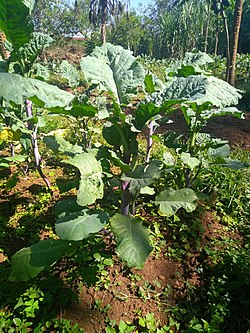Typical yield
12.5 t/ha
Varieties
2
Pest/Disease
2
Seasons
1
Profile
- Growth habit
- annual
- Lifecycle (days)
- 70-110
- Primary uses
- Leafy vegetable; oilseed types exist
- Pollination
- insect
- Origin / distribution
- Ethiopian highlands
Environment
Climate
Temp optimal
12–20 °C
Rain optimal
500–800 mm/yr
Altitude
1200–2800 m
Soil
pH optimal
6.2–7
Soil type
Fertile loam
Farmer Guide
Row spacing
50 cm
Plant spacing
30 cm
Depth
1.5 cm
Seed rate
4 kg/ha
Nursery days
25
Planting: Transplant at 4–5 weeks.
Irrigation: Maintain steady moisture
Harvest: Pick outer leaves continuously.
Nutrient Schedule
| # | Stage | DAP | Product | Rate | Targets (kg/ha) | Notes |
|---|---|---|---|---|---|---|
| 1 | Basal | 0 | NPK 17-17-17 | 80 kg/ha | N: —, P₂O₅: —, K₂O: — | |
| 2 | Topdress | 25 | CAN 26% N | 80 kg/ha | N: —, P₂O₅: —, K₂O: — |
Nutrient Requirements
| Nutrient | Stage | Amount | Unit |
|---|---|---|---|
| N | Basal | 50 | kg/ha |
| P₂O₅ | Basal | 25 | kg/ha |
| K₂O | Basal | 40 | kg/ha |
| N | Topdress | 30 | kg/ha |
Images

| Name | Country | Maturity | Traits |
|---|---|---|---|
| Carinata Local | ET | 80 | Vigorous, leafy |
| Local Carinata | KE | 90 | Tender leaves |
No fertilizer recommendations yet.
| Name | Type | Symptoms | Management |
|---|---|---|---|
| Diamondback moth | pest | Leaf holes | BT products; rotation |
| Downy mildew | disease | Pale patches, downy underside | Improve airflow; fungicides as needed |
| System | Typical | Min | Max | Notes |
|---|---|---|---|---|
| rainfed smallholder | 10 | 5 | 15 | |
| open-field | 15 | 10 | 25 |
| Country | Region | Planting | Harvest |
|---|---|---|---|
| KE | Highlands | Feb–Apr / Aug–Sep | Apr–Jul / Oct–Dec |
| Country | Region | Suitability |
|---|---|---|
| KE | Highlands | High |
